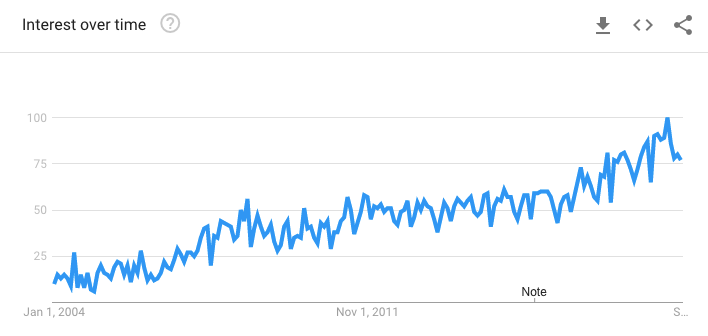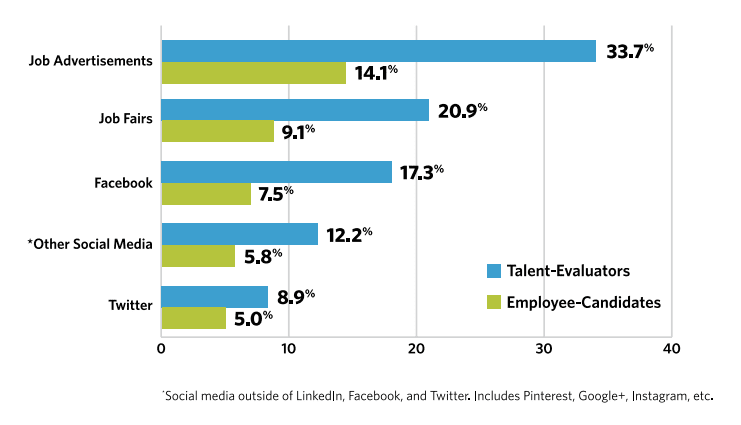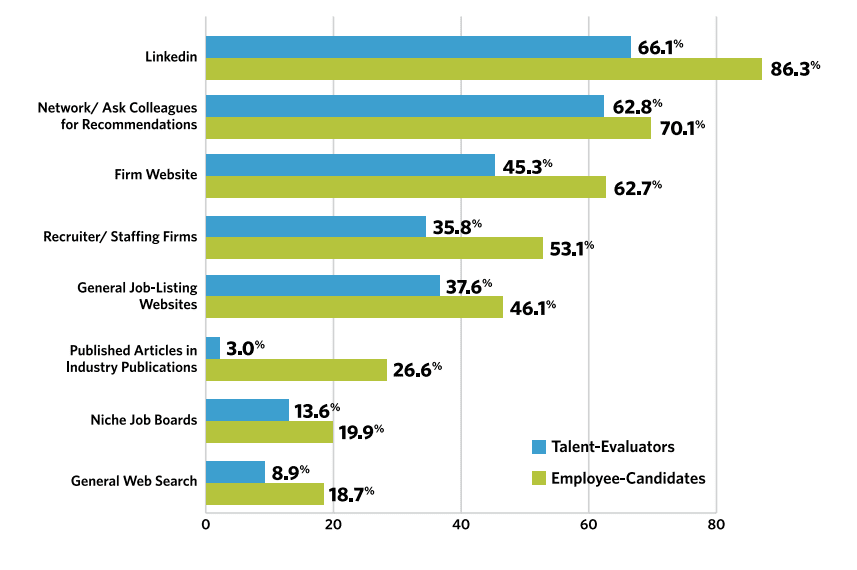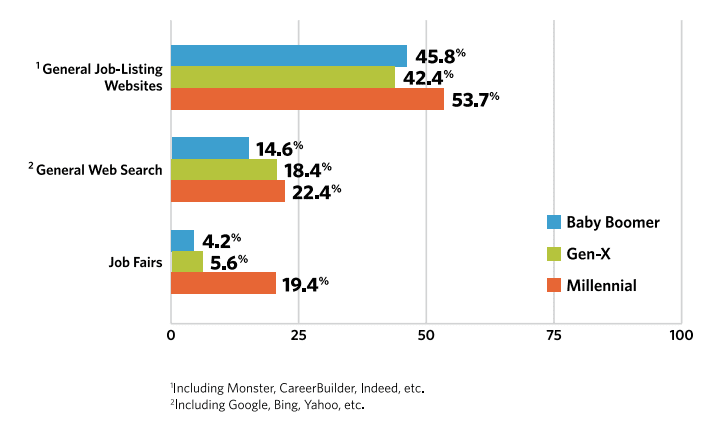In the past few decades, the concept and practice of employer branding has grown from obscurity to a highly valued marketing tool that businesses use to attract the high-quality people they need to remain competitive.
In fact, interest in the topic reached an all-time high this year, according to Google Trends (see Figure 1).

Much of this recent attention is almost certainly driven by today’s highly competitive job market. For firms in the professional services space, where talent acquisition has been a consistent challenge, it is especially relevant.
What’s more, as the pool of available labor continues to shrink, the challenge will only become more difficult.
Your firm may already have a formal employer branding program, or you may be considering launching one. In either case, it’s wise to make certain that you’re investing in the most effective employer branding techniques.
But how do you determine what works best for your organization?
What We’ve Learned about Best Practices in Employer Branding
A couple of years ago, my firm conducted a study of over 800 employee candidates and talent evaluators to understand which employer branding techniques they found most effective.
We were surprised to learn that many employers are investing in marketing platforms and opportunities that aren’t delivering the results the employers expected.
In fact, one-third of the firms we surveyed are essentially ignoring the one channel preferred by more than 86% of job seekers.
As shown in Figure 2, our research identified five employer marketing tactics that employers rely on at much higher rates than do the job seekers whom they are attempting to reach.
This means that firms are investing a lot of their marketing spend in places that prospective employees rarely look.
These marketing investments include placing traditional employment advertisements and taking part in job fairs — two “tried-and-true” techniques, perhaps … but ones that are becoming less and less relevant (I’ll explain why in a moment).

Figure 2. Marketing channels over-utilized by employers
It might surprise you to learn that even Facebook underperforms when it comes to reaching job seekers.
Facebook may be the digital home to more than a billion people but, when it comes to finding their next job, the great majority of professionals don’t consider Facebook a serious resource.
What’s more, Twitter, Instagram and other second-tier social media platforms also fail to attract many professional services job seekers – these platforms have their strength elsewhere.
So where should you be making your investments in promoting your employer brand? For the answer, the data shown in Figure 3 provide the answer.

Figure 3. Marketing channels underutilized by employers
Figure 3 makes it clear that LinkedIn is the single most impactful marketing channel for recruiting, because job seekers rely on it even more heavily than they do on networking and personal recommendations.
LinkedIn is the platform of choice for 86% of job seekers — yet only 66% of firms are actively searching LinkedIn for job candidates.
LinkedIn has not only become the leading platform for networking, it’s also the go-to choice for job candidates who are ready to find a new position.
Another valuable insight from our research is the importance of a firm’s website as a recruiting tool. One-third of all job candidates said they were likely to use firms’ websites when searching for jobs (a number that, quite frankly, we thought would be even higher).
Yet less than half of firms report that they actively use their websites to attract employees — thus, another large gap that could be a major recruiting opportunity for your firm.
As Figure 3 shows, job seekers also use staffing firms, job-listing websites and specialized job boards more frequently than do hiring firms.
Perhaps the most surprising finding of this part of our survey concerns the largest gap of all: the role that published articles can play in the recruiting process. According to our findings, three-quarters of job seekers want to work at a firm with a good reputation in the marketplace.
So it should not come as a surprise that a significant portion of job seekers (26%) regard published articles as a reliable sign of market leadership.
The opportunity comes in the fact that the vast majority of firms don’t consider their own firm’s thought leadership as an asset in their employer brand.
And when you think about getting employees active in social media channels, programs that encourage them to promote their firm’s thought leadership creates visibility not only to prospective clients, but to prospective talent.
Related: Dive into why employer branding matters for your company’s hiring success. Download our complete guide for free.
Different Generations, Different Perspectives
When looking at market research, it’s common to find one set of data that appears to contradict another set, even in the same study — that is, until you examine it more closely. Our research included the same apparent contradictions.
When we examined how different marketing channels are regarded by different age groups, there were many similarities, and also some dramatic differences.
One of the most surprising insights involved the differing views of job fairs, whose relevance to job seekers, as I mentioned earlier, may be on the decline.
However, when we sliced the data according to generation, we were originally surprised to learn that Millennials, the youngest respondents in our study, were 4-5X more likely to attend job fairs than their Gen-X and Baby Boomer peers (see Figure 4.)

Figure 4. Differing generational preferences in marketing channels
After some additional analysis, our best theory for explaining this surprising data is that job fairs are generally more suited to candidates who are earlier in their careers.
The great majority of executive-level positions, for example, are being filled via different channels.
So, should you still invest in job fairs as a recruiting channel? The answer will likely depend on what level of employee you are hiring.
That being said, the data from our research don’t seem to justify investing a great deal of resources into this channel.
Another insight from this part of our survey was not as surprising: Millennials tend to be more comfortable using digital platforms, including general job listing websites and broad-based web research.
What Are the Takeaways for Your Employer Brand?
Here are some suggestions for using these research findings to improve how you market your employer brand:
- Don’t underestimate LinkedIn. Job seekers are using this platform to find job opportunities and research firms far more frequently than they do with any other platform.
- Consider hiring a professional recruiter to leverage LinkedIn. These days, many recruiters use LinkedIn, with great success, to contact promising candidates, regardless of whether they are actively looking for a new position.
- Use your website to convey an appealing employer brand. Dedicate a page — several pages would be even better — to describe your workplace, culture and benefits, and why working at your firm is a better experience. The more you can use photos, employee testimonials and specific examples, the more persuasive your brand will be. And remember to talk about the meaningful work your firm does, as well as awards you’ve won and other factors that demonstrate your industry leadership and relevance.
- Don’t rely on Facebook as your recruiting homepage. The platform is perfectly suited for posting staff photos and funny memes — but it’s not where job hunters are heading to look for job openings or to learn about your firm.
- Be social. Whenever your firm has a job opening, let people in your network know. Remember that job seekers are constantly asking their friends and colleagues to find new opportunities.
- Post on both niche and general job websites. Today’s candidates look online for job opportunities — but in traditional print venues, not so much.
- Become thought leaders in your industry. Your firm’s thought leadership is at least as important to your client-facing brand as your employer brand. In both instances, Visible Expertise is a major win.
If you’ve been developing or maintaining an employer brand — or if you are simply looking for new ideas to attract the best talent — these insights should help you make better use of your time and budget.
Looking for any easy way to distribute employer branding content on social media? Want to get employees involved in creating content related to work culture? Learn how EveryoneSocial’s employee advocacy platform can help. Request your demo.
















